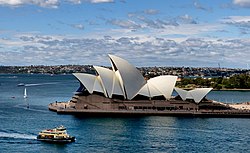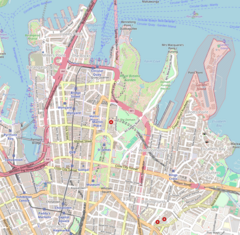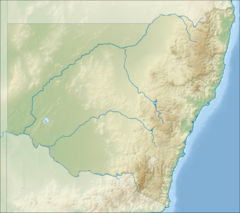| Sydney Opera House | |
|---|---|
 Official logo | |
 View from the west | |
| General information | |
| Status | Completed |
| Type | Performing arts centre |
| Architectural style | Expressionist |
| Location | Bennelong Point, Sydney |
| Country | Australia |
| Coordinates | 33°51′25″S 151°12′55″E / 33.85681°S 151.21514°E |
| Elevation | 4 m (13 ft) |
| Current tenants | |
| Groundbreaking | 1 March 1959 |
| Construction started | 1 March 1959 |
| Completed | 1973 |
| Opened | 20 October 1973 |
| Inaugurated | 20 October 1973 |
| Cost | A$102 million, equivalent to A$1082 million in 2022[1] |
| Client | NSW Government |
| Owner | NSW Government |
| Height | 65 m (213 ft) |
| Dimensions | |
| Other dimensions |
|
| Technical details | |
| Structural system | Concrete frame & precast concrete ribbed roof |
| Design and construction | |
| Architect(s) | Jørn Utzon Peter Hall |
| Structural engineer | Ove Arup & Partners |
| Main contractor | Civil & Civic (level 1), M.R. Hornibrook (level 2 and 3 and interiors) |
| Other information | |
| Seating capacity |
|
| Website | |
| sydneyoperahouse | |
| Type | Cultural |
| Criteria | i |
| Designated | 2007 (31st session) |
| Reference no. | 166 |
| Region | Oceania |
| Type | Historic |
| Criteria | a, b, e, f, g, h |
| Designated | 12 July 2005 |
| Reference no. | 105738 |
| Type | Built |
| Criteria | a, b, c, d, e, f, g |
| Designated | 3 December 2003 |
| Reference no. | 01685 |
| References | |
| Coordinates[2] | |
The Sydney Opera House is a multi-venue performing arts centre in Sydney, New South Wales, Australia. Located on the foreshore of Sydney Harbour, it is widely regarded as one of the world's most famous and distinctive buildings and a masterpiece of 20th-century architecture.[3][4]
Designed by Danish architect Jørn Utzon and completed by an Australian architectural team headed by Peter Hall, the building was formally opened by Queen Elizabeth II on 20 October 1973,[5] 16 years after Utzon's 1957 selection as winner of an international design competition. The Government of New South Wales, led by the premier, Joseph Cahill, authorised work to begin in 1958 with Utzon directing construction. The government's decision to build Utzon's design is often overshadowed by circumstances that followed, including cost and scheduling overruns as well as the architect's ultimate resignation.[6]
The building and its surrounds occupy the whole of Bennelong Point on Sydney Harbour, between Sydney Cove and Farm Cove, adjacent to the Sydney central business district and the Royal Botanic Gardens, and near to the Sydney Harbour Bridge.
The building comprises multiple performance venues, which together host well over 1,500 performances annually, attended by more than 1.2 million people.[7] Performances are presented by numerous performing artists, with many resident companies such as Opera Australia, the Sydney Theatre Company and the Sydney Symphony Orchestra. As one of the most popular visitor attractions in Australia, the site is visited by more than eight million people annually, and approximately 350,000 visitors take a guided tour of the building each year.[8] The building is managed by the Sydney Opera House Trust, an agency of the New South Wales State Government.
On 28 June 1998 the Sydney Opera House became a UNESCO World Heritage Site,[9] having been listed on the (now defunct) Register of the National Estate since 1980, the National Trust of Australia register since 1983, the City of Sydney Heritage Inventory since 2000, the New South Wales State Heritage Register since 2003, and the Australian National Heritage List since 2005.[10][11] The Opera House was also a finalist in the New7Wonders of the World campaign list.[12][13]
- ^ "Inflation Calculator". RBA. 14 February 1966. Archived from the original on 3 March 2017. Retrieved 10 March 2017.
- ^ Topographic maps 1:100000 9130 Sydney and 1:25000 91303N Parramatta River
- ^ Environment, Department of the (23 April 2008). "World Heritage Places – The Sydney Opera House – World Heritage values". www.environment.gov.au. Archived from the original on 10 May 2016. Retrieved 10 May 2016.
- ^ Maher, Alannah (30 July 2021). "Seven Sydney Opera House designs that never saw the light of day". Time Out. Retrieved 4 November 2021.
- ^ "Sydney Opera House history". Sydney Opera House Official Site. Archived from the original on 20 October 2013. Retrieved 17 October 2013.
- ^ "2003 Laureate". The Pritzker Architecture Prize. The Hyatt Foundation. Archived from the original on 22 December 2015. Retrieved 19 December 2015.
- ^ "Sydney Opera House 2015 Annual Report – Performing Arts" (PDF). Retrieved 19 December 2015.[permanent dead link]
- ^ "How do you value an icon? The Sydney Opera House: economic, cultural and digital value" (PDF). Deloitte Access Economics. 2010. p. 70. Archived from the original (PDF) on 22 December 2015. Retrieved 19 December 2015.
- ^ Braithwaite, David (28 June 2007). "Opera House wins top status". The Sydney Morning Herald. Archived from the original on 1 July 2007. Retrieved 28 June 2007.
- ^ "Sydney Opera House". New South Wales State Heritage Register. Department of Planning & Environment. H01685. Retrieved 3 September 2017.
 Text is licensed by State of New South Wales (Department of Planning and Environment) under CC BY 4.0 licence.
Text is licensed by State of New South Wales (Department of Planning and Environment) under CC BY 4.0 licence.
- ^ "Sydney Opera House, 2 Circular Quay East, Sydney, NSW, Australia". Australian Heritage Database. Department of the Environment and Energy, Australian Government. 12 July 2005. Retrieved 21 September 2017.
- ^ "New7Wonders of the World". World of New7Wonders.
- ^ "Sydney Opera House short-listed for new 'Seven Wonders'". ABC News.


